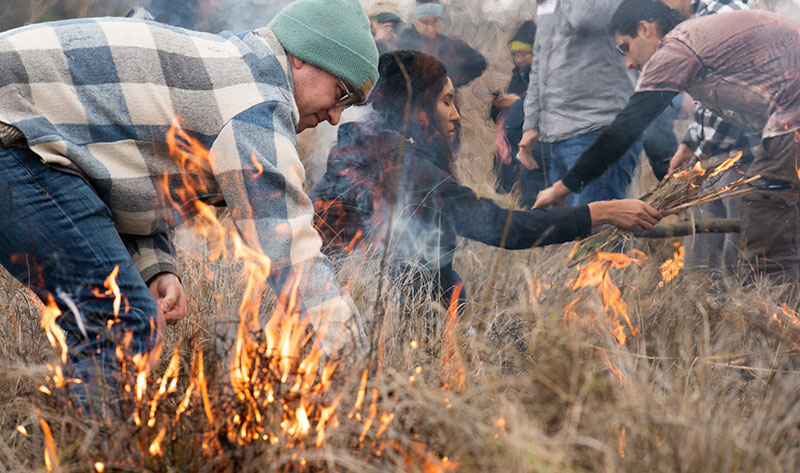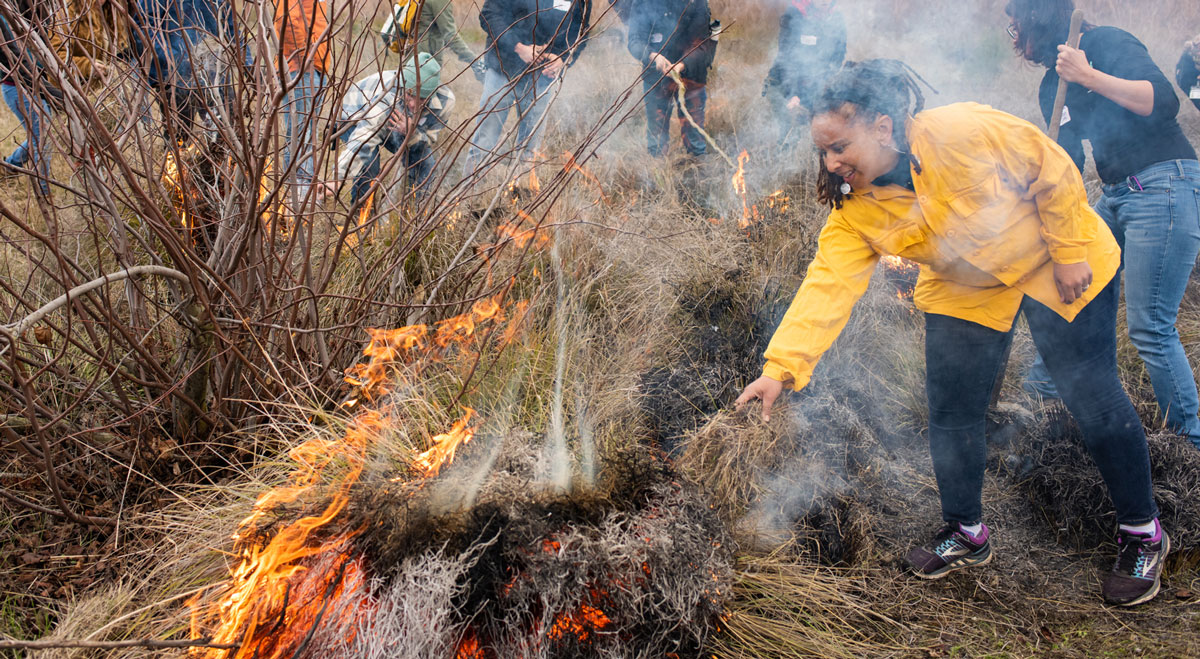Thoughts on Regenerative Fire Mitigation Part 2

UC Davis students, academics and members of the local Native American community take part in a collaborative cultural burn at the Tending and Gathering Garden at the Cache Creek Nature Preserve in Woodland. Photo Credit – Alysha Beck/UC Davis.
By: Mark Biaggi
< Part 1
 When thinking about a big problem like how to manage fire-prone landscapes, I often return to the writings of Stephen Covey who advocated that we begin with the end in mind. What do we want? What do we need? How will our actions impact the land, the environment, the people on the land, the life downstream, from the smallest microbe in the soil to the wildlife moving across the landscape?
When thinking about a big problem like how to manage fire-prone landscapes, I often return to the writings of Stephen Covey who advocated that we begin with the end in mind. What do we want? What do we need? How will our actions impact the land, the environment, the people on the land, the life downstream, from the smallest microbe in the soil to the wildlife moving across the landscape?
In the case of fire, the end I have in mind for the landscape I manage is not a landscape free of fire, but a fire-resilient one. In a fire-resilient environment, fire simultaneously cycles nutrients, reduces dangerous fuel build-up, and stimulates new growth. Fire is a natural part of the landscape after all and therefore a fire resilient community is one where humans and fire can coexist.
- In a fire-resilient forest, fires move slowly, “skunking” along the forest floor burning duff and consuming sick, dead, and dying trees. Slow-moving fires “scar” healthy trees, create cavities for wildlife to shelter, and stimulate cones and acorns to open and start the natural process of regrowth.
- In a fire-resilient grassland, fire consumes old and woody fibers no longer palatable to grazing animals releasing stored minerals back to the soil. Seeds get switched on by fire allowing new growth that will feed wild and domesticated herbivores. Areas choked by invasive species are opened up allowing space for perennial and native plants to reestablish.
To achieve this end, we need to plan carefully and thoroughly keeping in mind that Nature works to keep things in balance. When managing a fire-resilient landscape or grazing livestock, we think in a holistic way to improve the health of the land. Soil health and functioning water cycles are critical to make sure the plants have what they need to sprout or regrow after fire or grazing.
Managing land with the goal of creating a fire-resilient landscape means managing in ways that will prevent catastrophic fire and improve the land’s ability to respond to the beneficial aspects of fire. If I am considering placing a firebreak, for example, I think about not just where to place it but how it can be placed in a way that will stimulate soil structure and biology so the system can support plants and soil biology even after the disturbance has occurred.

UC Davis professor of Native American studies Beth Rose MiddletonManningthrows deergrass onto a burning pileas she and students in the “Keepers of the Flame”class take part in a cultural burn at theTending and Gathering Garden at the Cache Creek Nature Preserve in Woodland. Photo Credit – Alysha Beck/UC Davis.
Last spring before the CZU Complex Fire, and in order to promote vegetation and soil health, our Land & Livestock (L&L) team chose to rest the pastures on the east side of the ranch (no grazing) to allow plants to grow to their maximum potential and seed out for maximum seed production. We knew the ungrazed forage would be an important stockpile of “standing hay” for the herd to graze in the fall when grass might be in short supply. In August, however, dry lightning strikes created one of the largest wildfires in our region’s history. Suddenly our stockpile of 2-4 feet of standing dry grass became a liability and risk. In the face of this change of events, we monitored the fire daily as it crept toward us and grazed all that we could to reduce the fuel load in the case that the fires made it to the ranch.
During this experience, I jotted down questions and thoughts that came up for the L&L team in the heat of the moment (literally):
- How can we cut fire breaks without creating problems that need to be cleaned up afterward?
- Before we “drop the blade” on the bulldozer and scrape a pasture bare, what is the long-term impact when the rains return? Can we make a fire break in a way that minimizes potential erosion and/or work needed to remediate the impact?
- How did indigenous land management practices reduce the risk of fire, fire ladders, and fuel loads while managing for sustainable food production?
- How can we create fire breaks using alternative methods so we don’t have to scrape our land bare with bulldozers? Is grazing our pastures down short (often called overgrazing) including around facilities, road edges, and property lines a more environmentally friendly way to reduce risk and diminish the intensity of fire while not disturbing the delicate balance of soil and plant roots?
Next month, I will describe some of the experiments and trials we are doing in the hopes that we can begin to answer these questions and identify practices that help us create a fire-resilient TomKat Ranch.